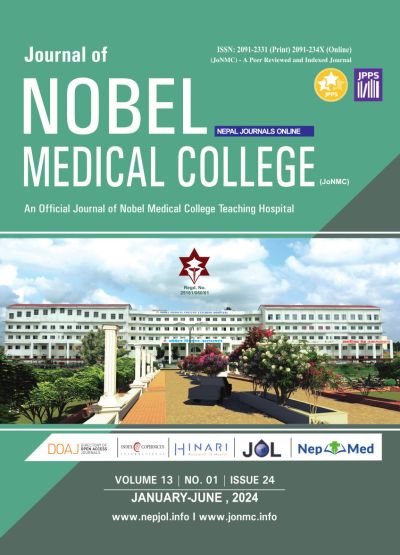Determinant of Bronchoarterial Ratio in a Patient Undergoing Computed Tomography Chest
DOI:
https://doi.org/10.3126/jonmc.v13i1.68110Keywords:
Airway Remodeling, Arteries, Bronchi, Respiratory Tract DiseaseAbstract
Background: Respiratory diseases pose a significant challenge in Nepali clinical settings due to elevated smoking rates and environmental risks. This study explores the structural changes in conditions such as asthma, chronic obstructive pulmonary disease, and bronchiectasis, utilizing noninvasive multi-detector computed tomography to assess airway remodeling. Despite conflicting western literature on bronchoarterial ratios, this research emphasizes the importance of evaluating these ratios in the Nepalese context for predicting airway disease severity.
Materials and Methods: The cross-sectional study conducted at Nobel Medical College and Teaching Hospital involved 129 participants aged over 20 undergoing chest computed tomography. It aimed to measure the bronchoarterial ratio and investigate its associations with age, gender, smoking history, and altitude of residence. Bronchoarterial ratios was calculated using averaged short-axis diameters of the right apical and right posterior basal segmental bronchi, excluding the left lung due to motion artifacts.
Results: Analysis indicated a Mean Bronchoarterial Ratio of 0.823 (SD 0.151), with the apical and basal segment BARs at 0.832 (SD 0.148) and 0.814 (SD 0.153), respectively. Notably, individuals aged over 65 who were smokers exhibited a significant increase in BAR. Additionally, a higher altitude of residence demonstrated a significant correlation with the Bronchoarterial ratio in the apical lung segment.
Conclusion: This study provides valuable insights into the bronchoarterial ratio within the Nepalese population, considering age, gender, smoking history, and altitude of residence. The findings underscore the potential relevance of these ratios in conditions involving airway remodeling, contributing to the understanding of respiratory diseases in this specific demographic.
Downloads
Downloads
Published
How to Cite
Issue
Section
License

This work is licensed under a Creative Commons Attribution 4.0 International License.
JoNMC applies the Creative Commons Attribution (CC BY) license to works we publish. Under this license, authors retain ownership of the copyright for their content, but they allow anyone to download, reuse, reprint, modify, distribute and/or copy the content as long as the original authors and source are cited.




